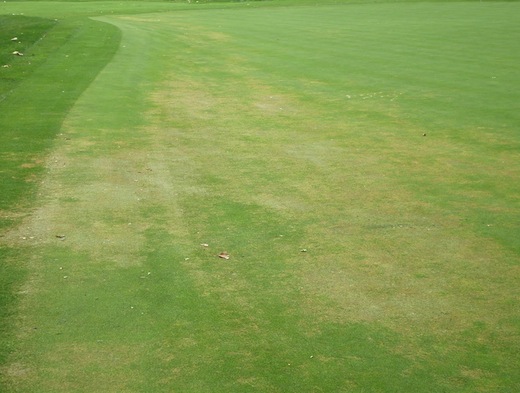Wet Wilt Injury Showing Up on Putting Greens
July 25, 2013 in Articles, Extension
The following is a modified version of an article posted in 2010, when rains and high temperatures combined to produce a physiological condition known as “wet wilt” on putting greens.
The unusually hot and humid weather during the week of July 15 to 21 led to some turf losses in poorly drained areas on putting greens in PA. Some of this damage can be traced to a phenomenon known as wet wilt. Wet wilt occurs when high (>90°F) soil temperatures and low oxygen levels (due to moist or wet soils) cause impairment of root function. The consequence of low soil oxygen is that roots cannot take up water fast enough to meet the transpiration cooling and water demands of Poa annua turf. Thus, on extremely hot days, the turf begins to overheat, wilt, and eventually die, despite the fact that there is an adequate supply of water in the soil. Although overheating (sometimes called supraoptimal heating) of turf is considered a separate cause of injury, wet soils and overheating often occur together, making a bad situation worse.
Syringing and use of fans are the most common means of cooling the turf and reducing the chance of wet wilt. Syringing involves applying a light spray of cool water over the turf surface to reduce plant temperatures. The key to successful syringing is to cool the plants without adding more water to the soil. If placed in the right locations, fans can also help to alleviate overheating, especially when combined with syringing.
Wet wilt is more severe on Poa annua ‘push-up greens’ with drainage issues and in situations where root systems are shallow and near the soil surface (where they are exposed to high soil surface temperatures). Suggested preventative measures to reduce the occurrence of wet wilt episodes include improving drainage on the most wilt-prone greens, and prompting better root development. Although improving drainage is always a challenge on push-up greens, installation of a series of silt trenches that are back-filled with sand can help. Silt trench systems will allow water to move off the surface of the greens, through sand-filled channels, and eventually to a drain tile. Companies that are proficient in installing these systems are XGD Systems and Golf Preservations, Inc. It is important to realize that these systems will not prevent all drainage-related problems in the future, and that soil-based push-up greens with low areas can still remain wet following heavy rains.
One means of improving root development in greens is through a regular program of core aeration (fall and spring), and perhaps deep-tine aeration. Holes that are produced by coring and backfilled with sand will allow roots to penetrate deeper in the soil and create more branching and increased surface area. Coring will also remove some thatch and mat (which may impede drainage and hold excess moisture). Although core aeration disrupts the putting surface, it’s a required maintenance practice that yields dividends down the road. Deep-tine aeration also will help create deep channels and fractures that encourage internal drainage and root development.
Applications of fungicides for control of Pythium, summer patch, anthracnose, and other summer diseases may help the turf survive during periods of high heat and humidity. A regular program of spiking and/or needle tine aeration will help toxic gases escape from soil and allow oxygen to diffuse into the root zone.